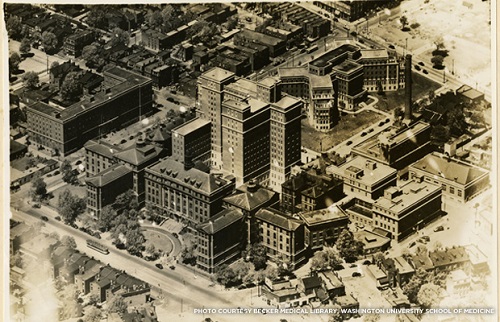Gallery Contents

A postcard of the historic old City Hospital complex. In 1845, the City of St. Louis founded the City Hospital in response to a widespread cholera outbreak. The original City Hospital was unfortunately destroyed by a fire in 1856, rebuilt a year later, and destroyed again by the Great Cyclone of 1896. Its third and final reincarnation was led by famed architect Albert Groves, who designed it with the Georgian Revival Style that survives today. At its apex in 1970, the City Hospital complex had over a dozen structures, including its own power plant (the building with the smokestack), a laundry building (to the power plant’s immediate right), and the Malcolm Bliss Hospital (the X-shaped building at top).
Photo by Blog.PreservationNation.org

Despite the City Hospital complex’s prestige in the City of St. Louis, its survival turned dire towards the end of the twentieth century. The Homer G. Phillips Hospital had been closed in 1979, putting immense pressure on the complex’s remaining infrastructure. Plans were later announced to relocate City Hospital to Delmar Ave, near University City. After 140 years of service, the old City Hospital complex was shut down in 1985. Some of the buildings were purchased for future development, but eventually the entire complex was turned over to the city’s Land Reutilization Authority in 1992.
Photo by BuiltStLouis.net

A view facing the Administrative building of the old City Hospital complex. After its closure and failed redevelopment attempts, the entire complex fell prey to vandals, graffiti artists, and other elements. Valuable materials were stripped from many buildings, including copper pipes and wiring. At one point, stray shrubs were growing through the Administrative building’s roof.
Photo by Amy Lampe

A 2002 aerial photo of the old City Hospital complex. The complex finally began to see needed action after the turn of the century. The City Hospital was listed in the National Register of Historic Places, making it eligible for federal and state tax credits. A massive environmental cleanup effort commenced shortly thereafter, addressing high levels of asbestos and lead, as well as the removal of underground storage tanks (USTs). This was made possible through a combination of incentives, including an EPA Assessment Grant, a HUD Economic Development Initiative Grant, Brownfields State Remediation Tax Credits, State Historic Tax Credits, and HUD Section 108 loan funds.
Photo by BuiltStLouis.net
Administrative Building

Travelers exiting highways 44 and 55 will first encounter the Administrative Building of the old City Hospital complex, built between 1910 and 1912, and one of the first structures on site to be successfully renovated after the complex closed in 1985. Redeveloped by Gilded Age, it is now known as The Georgian Condominiums, offering over 100 residences with numerous amenities, including 360 degree views around St. Louis. For more information, see our Brownfield Success Story on The Georgian (coming soon), or visit The Georgian website (http://www.gilded-age.com/georgian.html).
Photo by Amy Lampe
Power Plant Building

As the old City Hospital complex grew during the mid 1800s, the need for more electricity arose. The first power plant was built in 1878 as a two story brick structure, with multiple additions to the site until its final form emerged in 1937. After the old City Hospital complex was closed in 1985, the Power Plant saw multiple reuse and demolition plans arise and collapse. A joint effort by Environmental Operations, Inc. and Gilded Age gave the Power Plant life again, and the Power Plant building is now occupied by Climb So iLL indoor climbing gym (http://www.climbsoill.com/) and Element Restaurant and Lounge (http://www.elementstl.com/). For more information, visit their websites, or see our Brownfield Success Stories on each (coming soon).
Photo by Evin Russell
Laundry Building

Along with the Power Plant building – its next-door neighbor – the Laundry Building was another New Deal-era public investment. Completed in 1940 by the Public Works Administration, the Laundry Building was built to serve the old City Hospital complex. The Laundry Building closed its doors with the rest of the complex in 1985. After the complex was listed on the National Register of Historic Places, the City of St. Louis and Gilded Age Developers were able to move forward on remediation and redevelopment. The Laundry Building is now home to Palladium St. Louis, a private event space that can accommodate hundreds of guests for weddings, receptions and other events. For more information, visit our Brownfield Success Story (coming soon), or visit Palladium St. Louis’ website (http://www.palladium-stl.com/).
Photo by Google Maps
Butler's Pantry

Butler’s Pantry and the building it resides in are both new additions to the old City Hospital Complex. This catering and event planning business first opened in 1966, and was originally located on Delmar Blvd near Highway 170, where the House of India resides today. For more information, visit their website (http://butlerspantry.com/).
Photo by Google Maps
A.T. Still University

Under construction today is the A.T. Still University – Missouri School of Dentistry & Oral Health. The St. Louis City location will give ATSU its third campus; the medical institution currently has two campuses in Kirksville, Missouri, and Mesa, Arizona. The new 79,000 square foot facility is being built on the site of the former Malcolm Bliss Psychopathological Institute. A groundbreaking ceremony for the upcoming dental education and oral health clinic was held in April of 2014.
Photo by Evin Russell
More Photos and Videos
View all videos and photo galleries
